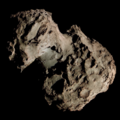ASTER (spacecraft)
| Mission type | Technology, reconnaissance |
|---|---|
| Operator | Brazilian Space Agency (AEB) |
| Mission duration | Cruise phase: 1.8 years Science phase: 4 months[1] |
| Spacecraft properties | |
| Spacecraft | ASTER |
| Bus | MetNet[1] |
| Manufacturer | Brazilian Space Agency and its Brazilian partners |
| Launch mass | 150 kg (330 lb), including 66 kg (146 lb) xenon propellant[2] |
| Dry mass | 89 kg (196 lb) |
| Payload mass | 30 kg (66 lb)[2] |
| Power | 2.1 kW [3] |
| Start of mission | |
| Launch date | June 2025 [2] |
| Asteroid 2001 SN263 orbiter | |
| Orbital insertion | September 2027 [1] |
| Instruments | |
| Imaging camera, mass spectrometer | |
ASTER is a planned space mission under development by the Brazilian Space Agency that will launch a spacecraft to orbit a near-Earth object known as (153591) 2001 SN263, a triple asteroid system. The launch is scheduled for 2025, with a rendezvous in 2024/2027.[2]
According to de Brum et al. 2021,[4] the launch is planned for June 2022 (asteroid arrival in December 2024) or June 2025 (arrival September 2027).
The mission is not on the list of projects considered by the AEB for the 2022-2031 period.[5] Nor was the list of projects from 2005-2014 or 2012-2021.[6][7]
Overview
Brazil is promoting
The spacecraft is designed around the small Russian-Finnish
The target is
Objectives
The primary objective of ASTER project is to promote
The science objectives include measurements of the bulk properties of the triple asteroid system (size, shape, volume, density, dynamics, spin state, and rotation speed), the internal properties (structure, mass distribution, gravitational field) and surface properties (mineral composition, morphology, elemental composition).[1][3][8]
ASTER may carry an astrobiology experiment to determine the viability of some selected microorganisms in deep space, and it may also measure the deep space plasma environment along the trajectory.[8]
Science payload
The 30 kg (66 lb) science payload consists of: [3][8][9]
- Imaging Camera, a multispectral camera with wide and narrow-band
- Laser rangefinder, called ASTER Laser Rangefinder (ALR), will map the surface and texture of the target asteroids, and perform a geodesic and geophysical characterization with a ≤10 m precision. Its mass is <5 kg, and the power required is < 20 W [3]
- Infrared spectrometer, to determine surface composition
- Mass spectrometer, to determine the asteroid surface composition
- Synthetic aperture radar(SAR), to produce two-dimensional images or three-dimensional reconstructions of the asteroids
- Along the trajectory, some microbiology experiments may be performed to measure microorganisms' survival in deep space.
Solar electric propulsion
| Permanent Magnet Hall Thruster (PMHT)[2] |
Units |
|---|---|
| Designer | University of Brasília |
| Number of thrusters | 4 (two are spares) |
| Power from solar panels | Average: 2.0 kW[3] |
| Power consumption | 450 W per thruster |
| Thrust | 40 mN per thruster |
| Specific impulse (Isp) | 2,300 seconds |
| Thruster dimensions | Diameter: 15 cm (5.9 in) Length: 10 cm (3.9 in) Mass: 4.5 kg (9.9 lb) |
| Propellant | 66 kg (146 lb) of xenon |
The spacecraft features a type of
The spacecraft architecture plans to mount four PMHT plasma thrusters, where two will be spares. All four thrusters operating simultaneously produce 160 mN, although the ASTER mission can be performed with thrust in the interval between 80 mN to 120 mN of total thrust.[2]
The spacecraft will be launched to low Earth orbit (approximately 400 km altitude), where it will then use its plasma thrusters to increase its speed and raise its elliptical orbit until it reaches escape velocity for an heliocentric transfer to the asteroid. Complex modeling was done to determine techniques to safely orbit the triple system at close range.[11]
Target asteroid system
The 2001 SN263 triple asteroid system is a carbonaceous (C-type asteroid) from the Amor asteroid group.[8] Such asteroids hold clues of the initial stages of planetary formation and also the origin of water and abiogenesis on Earth.[8] The main central body is an irregular object with a diameter about 2.8 km, while the other two are small objects 1.1 km and 0.4 km across.[2][9]
See also
References
- ^
- ^ Georgia Institute of Technology. IEPC-2017-166. Archived(PDF) from the original on 4 August 2022.
- ^
- ISSN 0273-1177.
- ISBN 978-65-980268-1-3.
- ^ Brasileira, Agência Espacial (2005). Programa Nacional de Atividades Espaciais – PNAE 2005-2014 (PDF) (in Brazilian Portuguese). Brasilia: Agência Espacial Brasileira. p. 114.
- ^ Brasileira, Agência Espacial (2012). Programa Nacional de Atividades Espaciais – PNAE 2012-2021 (PDF) (in Brazilian Portuguese). Brasilia: Agência Espacial Brasileira. p. 36.
- ^ a b c d e f g ASTER: A Brazilian Mission to an Asteroid. (PDF) O. C. Winter, E. E. N. Macau, H. de Campos Velho, V. Carruba1, and the Scientific and Engineering Payload ASTER Team.
- ^ a b c d e The ASTER Mission: Exploring for the First Time a Triple System Asteroid. (PDF) Elbert E.N. Macau, Othon Winter, Haroldo Fraga de Campos Velho. January 2011
- ^ ASTER Mission: First Brazilian Deep Space Mission, planned to be launched in 2014. The Aster Project: Flight to a Near Earth Asteroid. A. A. Sukhanov, H. F. DE C. Velho, E. E. Macau, O. C. Winter. Cosmic Research, 2010, Vol. 48, No. 5, pp. 443–450
- ^ ASTER Mission: Stability regions around the triple asteroid 2001 SN263. (PDF) O. C. Winter, R. A. N. Araujo, A. F. B. A. Prado, A. Sukhanov. 2011




